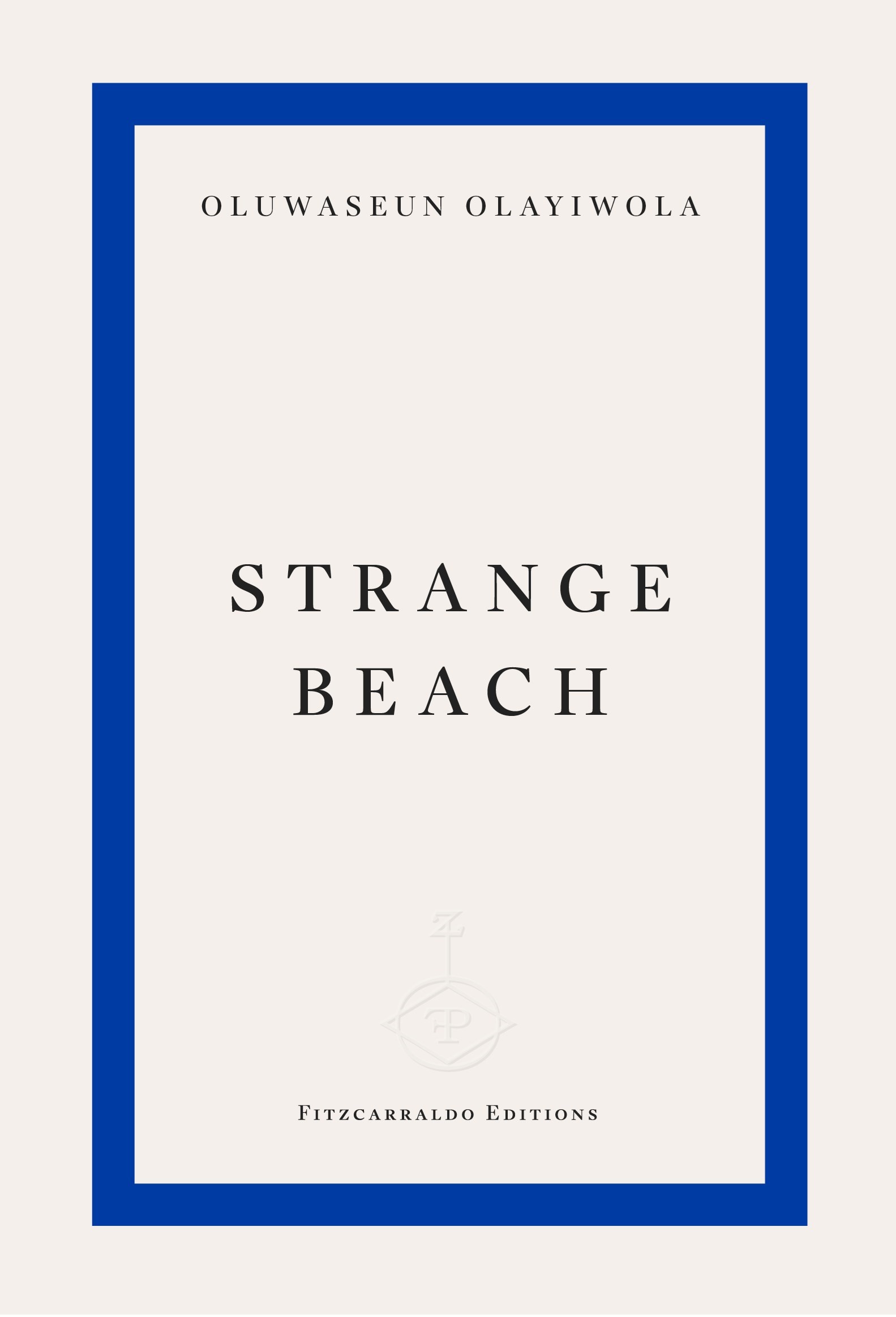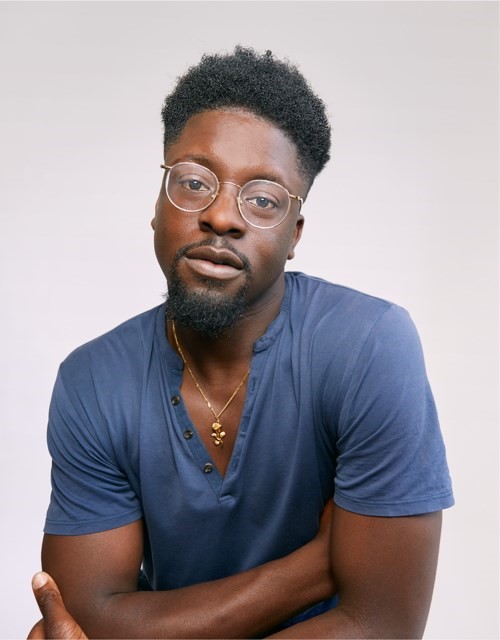When does a poem begin? For Oluwaseun Olayiwola, this question is hard to answer. “Does it begin when you have a feeling that instigates the precipitation of language?” he asks. Or is it “the moment you actually start writing it down? The moment it’s drafted? The moment you know it might be done?” There is a fluidity to the process of creation, and it is this notion of fluidity that Olayiwola, a London-based poet, choreographer, and critic, explores in his debut book Strange Beach.
Taking its title from Claudia Rankine’s book Citizen: An American Lyric, which features the lines, “No, it’s a strange beach; each body is a strange beach,” Olayiwola uses this figurative landscape as a space to examine relationships, identity, and existential queries. In an ecological exploration of the self, on this strange beach the binaries “between body and mind, invisible and visible, land and earth” are unsettled. “Do not touch me now,” he writes, “unless you / mean me / to open, open farther than this beach.”
Strange Beach is the inaugural book to be published by Fizcarraldo Editions on its newly established poetry list. Having released only fiction and non-fiction works until now, by Nobel Prize winners such as Olga Tokarczuk and Annie Ernaux, the cult publishing house has extended its press with Olayiwola as its first poet. “It is gratifying for my first work to be seen as being able to be in conversation with writers like that,” he says.
A dancer as well as a poet, below, Oluwaseun Olayiwola talks about his practice, the influences of artists such as Dorothea Tanning on his work, and writing in solitude.

Jessica Heron-Langton: Can you tell me about the process of creating this poetry collection?
Oluwaseun Olayiwola: The title Strange Beach comes from a passage in Claudia Rankine’s book Citizen: An American Lyric, which I first read in 2016. So, it has been nine years since I first encountered Strange Beach as an idea. Even then I knew it was a title, so much so that I named a dance after it .. I don’t know if I wasn’t satisfied with the dance, or if I felt like there was more to explore, but that title stayed with me.
I started writing the poems in 2020. Some were written a year or two before, but those were a first attempt, like learning to paint when you don’t really know what you’re doing. 2020 was when I really understood poetry as a way of thinking, a way of living.
JHL: 2020 was such a tumultuous year. How did that landscape influence you creatively?
OO: The poems have the flavour of 2020 in their cultural indications. There’s a poem called Chlorine, for example, that has George Floyd’s name in it. There are some poems that mention disease and My Mother Raised a Normal Man, which tries to think about Blackness in a head-on way. But more than those cultural indicators, it was the sense of solitude that really made its way into my work – this profound, and sometimes terrifying, sense of aloneness.
In 2020 I was staying with a partner, but I was by myself for long periods of the day. It was in those periods I felt able to write, or that I had to write. After I got out of that relationship, I looked back on those poems. It was this moment that really solidified my desire to be a writer.. Even through the depressive, grey, melancholic state that became the weather of 2020, there was still a consciousness moving through it, documenting it, taking notes, persisting.
JHL: Robert Lowell has been referenced in relation to your book. Do you consider Strange Beach to be a work of confessional poetry?
OO: I don’t know if it’s confessional. There is a quote from Sharon Olds that says people confuse autobiographical writing with confessional writing. She said it’s not confessional because they don’t have anything to confess. That really stayed with me. It made me wonder, what am I telling the reader about myself? Confessing is not just telling people things, it’s an attempt at a spiritual cleansing. Or perhaps asking the reader to forgive you? I don’t know if I’m asking the reader to forgive me.
“It was the sense of solitude that really made its way into my work – this profound, and sometimes terrifying, sense of aloneness” – Oluwaseun Olayiwola
JHL: You’re a dancer as well as a poet. How do these practices inform each other?
OO: I don’t see them as two different practices, like in this moment I’m a choreographer and then this moment I’m a poet. I let the sensations, the rhythms, the eccentricities of their forms sit inside the truth of my practice at all moments. It’s about negotiating what kind of fidelity I want to have.
As a choreographer, I’ve gotten very good at improvisation, but Ski was a poem that demanded something not improvisational. It was saying, you need to be slow with me. You need to revise me and redraft me. You need to find the rhythm, the tone, the speed. These were things that weren’t asking for the dancer version of me, it was asking for the writer version of me. This required a lot of work, which isn’t to say choreographic practice isn’t work, it was just that I couldn’t rely on that choreographic sense of rightness.
JHL: What is a choreographic rightness?
OO: To me, choreographic rightness is something about presence. When I’m dancing, I don’t feel the future or past, I feel the here. Good poems do the same thing. They draw you into the present. Ski wanted to go around a topic, not with a physical, imagistic language, but with abstract, orbital language. That, for me, was a very writerly task.
“Confessing is not just telling people things, it’s an attempt at a spiritual cleansing. Or perhaps asking the reader to forgive you” – Oluwaseun Olayiwola
JHL: Ski reminded me of a painting by Peter Doig, of a man at the top of a mountain with skis on his back like a cross. I read that some of your poems are in response to artworks by Dorothea Tanning and Edward Munch. What about these paintings spoke to you?
OO: I went to a Peter Doig exhibition the year I wrote that poem. That image felt very powerful to me, so I’m glad it came across for you. There is a quote by Rachel Cusk that says, “It is possible to look at a painting and not see anything at all. There must be an offering of the self before the painting will open.”
With Tanning and Munch, I felt unable not to open myself to their work. There was something about their form, their texture, their mood, that demanded I stay with them a little longer. They’re different painters, but there is a visceral-ness to their work, which comes back to this idea of the choreography. I felt my body charged, physically and physiologically, in encountering them. There are objects from those paintings that make their way into the poems. The plucked sunflowers in Strange Beach come from one of Tanning’s earlier works, these anthropomorphic sunflowers.
JL: What do you want people to take from these poems?
OO: To attend to your life rather than withdraw from it. There are sub-arguments about who’s allowed to be in nature, who’s allowed to have such depth of feeling, and who’s allowed to be abstract, nuanced. But I have the sense [that] the more we ask people what it’s like to be themselves, the more we realise we are all alike. Not in a kumbaya way! But there’s something in asking people to be specific with their use of language, to ask people to describe something that’s happened to them, that allows us to see there is a commonality between us. The more specific you can be about your story, the more that story becomes about the collective. The way you get to the universal is to be specific about your life. I hope that’s what people take away.
Strange Beach by Oluwaseun Olayiwola is published by Fitzcarraldo Editions, and is out now.
